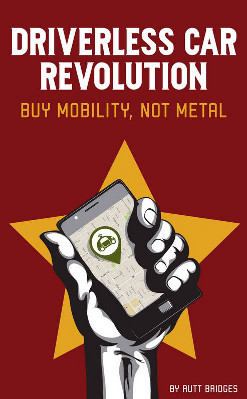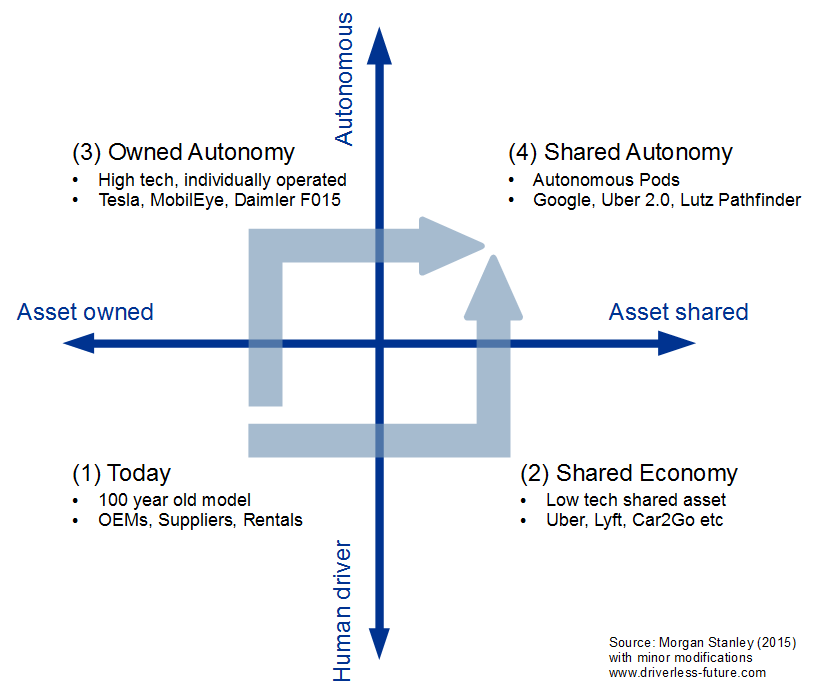Two and a half years ago I wrote a note on the various views about the paths for adopting self-driving vehicles. Since then, more and more signs point towards my ‘avalanche’ model, where the adoption of self-driving cars becomes a self-sustaining, accelerating process fueled by expectations of a fundamental transformation of the auto industry and major opportunities for profit.
As a thought exercise, I have sketched a hypothetical timeline which shows how this self-accelerating global innovation process could unfold. The purpose of the timeline is to show how autonomous vehicles could come into widespread use rather quickly and what kind of market and political forces could be involved. This is an extreme of many possible futures for self-driving cars:
2015 Google launches first short-range fully autonomous vehicle service in California at NASA Ames (not on public roads) and possibly in Mountain View (small scale pilot, limited to Google employees).
2015 The first auto makers (Daimler, Honda, Nissan?) announce major strategic initiatives and major investments to counter Googles’ threat and rapidly bring vehicles capable of full autonomy (Level 4) to the market.
2015 Car2Go (Daimler’s shared mobility service) announces a roadmap for autonomy in their car fleet.
2015 Automotive industry recognizes the implications of fully autonomous vehicles (transformation of mobility, significantly lowered worldwide demand). Analysts pound auto makers on their Level-4 autonomous vehicle strategy. Share prices begin a long decline.
2016 Google announces that their short range, limited-speed fully autonomous vehicle fleet will be built by Ford, Magna or others.
2016 China launches a major program to develop and deploy shared autonomous vehicles for local mobility. It recognizes that it can reduce infrastructure expenditure, jump-start their autonomous vehicle industry, reduce the ecological footprint of mobility etc.
2016 Google expands their short range autonomous vehicle service pilot to another US city that sees little rain and no snow, e.g. Las Vegas, NV or Sun City, AZ and starts their first overseas fleet.
2016 Price for semiconductor lasers used in LIDAR sensors falls below USD 150; this reduces the hardware/computing power costs for autonomous vehicles with 3D Lidars to below 10,000 USD.
2016 Transformative potential and benefits of autonomous vehicle technology are recognized widely. There is a bitter debate about the destruction of jobs.
2017 Several European countries have now adjusted their laws to allow the operation of fully autonomous vehicles on a national scale (not in international traffic).
2017 Autonomous long haul highway trucks start testing in the US, Europe or Japan.
2017 Rental car companies launch their own autonomous mobility inititiative.
2017 An international body for regulating autonomous vehicles is being formed in cooperation between the US, Europe and Japan.
2017 Google vehicles are now capable of driving in snow on pre-mapped routes.
2017 Automotive suppliers (Continental, Bosch, Valeo, or others) announce their own autonomous vehicles or special-purpose autonomous machines.
2017 Major road infrastructure projects are downsized because autonomous and connected vehicle technology have reduced the expectations on future transportation demands.
2017 Google moves their autonomous vehicle operations into a subsidiary which then merges with Uber and starts to roll out local autonomous vehicle mobility services in many more US cities.
2017 Singapore deploys the first autonomous bus for regular service. This is widely seen as a milestone for public transport and sends many transit corporations scrambling to update their strategies.
2017 The first countries mandate specific driving behavior for self-driving cars in certain driving situations.
2018 Car2Go starts to add autonomous vehicles to their fleet.
2018 The Google subsidiary/Uber merger rolls out autonomous vehicles internationally.
2018 Heavy investment into autonomous vehicle fleets and services based on autonomous vehicles. An almost unlimited amount of capital flows into startups and schemes. Countries compete trying to gain an advantage in the emerging new industries.
2018 Experience with autonomous vehicles shows that they are indeed much safer than the average human driver. People feel safe and comfortable in fully autonomous vehicles and there is no longer any question of user acceptance. No phenomenon similar to the ‘fear of flying’ can be found among users of self-driving cars.
2019 The Vienna Convention and European Laws are updated to allow the operation of fully autonomous vehicles.
2019 Autonomous vehicles now operate in over 50 cities worldwide.
2019 Rapid growth for autonomous trucks on specific routes. In many countries, truck drivers protest but this can only delay their adoption slightly.
2019 The first high-end consumer cars capable of fully autonomous driving on a large part of the national road network become available.
2020 The first countries introduce laws that prohibit bullying of autonomous vehicles (e.g. jumping in front of it to make it stop).
2020 Bleak outlook for automobile companies. Volume is down, consumers prepare for the transitioning to fully autonomous vehicles (which are not yet widely available for the consumer) or increasingly use/expect to use shared autonomous vehicle services. The fight for survival has begun: The auto industry has its “Kodak moment”.
2022 Prices for used cars decline. Too many people switch to shared autonomous vehicle schemes. Many others sell their old vehicles prematurely because they want to switch to the much safer fully autonomous models where they don’t need to drive if they don’t want to.
2022 The cost for autonomous vehicle hardware (sensors and computing power) has come down to 1500 USD.
2022 Mass transit companies increasingly rely on autonomous vehicles for transport. Transitioning the current workforce to a transit system based on autonomous vehicles is a major organizational and political challenge.
2022 Insurance rates favor operating cars in fully autonomous mode and prompt many people to stop driving on their own.
2023 Small autonomous buses are increasingly used for medium- and long distance trips. Trains have a hard time to compete on short to medium distances with autonomous buses.
2023 Most companies require that business trips with rental cars must occur in fully autonomous mode (for safety and productivity reasons).
2025 Fleets of autonomous vehicles now operate in most cities of developed nations.
2025 Automotive companies shut down more and more plants. Major automotive countries including Germany, Sweden and Japan desperately try to prop up their OEMs.
2030 Car ownership has declined dramatically. Only 20% of the US population still own a car (200 cars for 1000 people, today: 439 cars for 1000 people). 90% of all trips now happen in fully autonomous mode. Traffic accidents and fatalities have declined dramatically.


